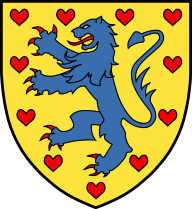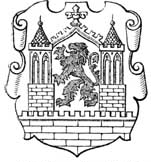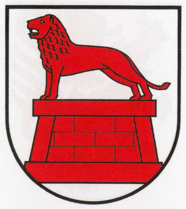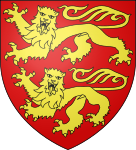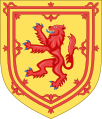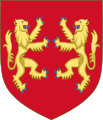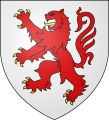Coat of arms of the city of Braunschweig
|
Braunschweig Lower Saxony |
|
|---|---|

|
|
| Blazon | |
|
|
| City colors and flag | |
| Red White | |
| Basic data | |
| Legal basis: | Seal management: since 1231 |
| Supporting documents: | The lion is already present in the seal. |
| Former municipalities with their own coat of arms: |
Altstadt , Neustadt , Hagen , Altewiek and Sack |
The coat of arms of the city of Braunschweig shows a red lion in front of a silver (white) background. It goes back to the city's medieval seals. The lion can be found in heraldry as a heraldic animal under its own designation as " Braunschweiger Löwe ". As a so-called common figure , the lion stands for royal dignity and courage. As a symbol of royal claim or loyalty to the king, the lion was used, for example, by Robert the Bruce , William Wallace , Richard the Lionheart and Henry the Lion .
Its appearance: The lion stands upright on one rear paw, the second is raised as if to step, the front paws are stretched out far forward and form almost a right angle to one another. The lion's body is red, the claws and eyes are black, and the six teeth in the open mouth are white. He sticks out his tongue. The tail is raised to the same height as the head and is undulating with five parallel red stripes, which run obliquely to the right from the inside bend. The view shows the left side of the animal, it turns to the right. The tail end ends in a three-part tassel.
history
The heraldic animal of Brunswick was already preferred by the Guelphs , who dominated Lower Saxony at the beginning of the heraldic era. A well-known offspring of their dynasty was the Duke Heinrich, who became known under the name Heinrich the Lion . His castle lion from 1166, the original of which is now in Dankwarderode Castle in Braunschweig, is known far beyond the city's borders. In order to increase their reputation and position, the Guelphs adopted the coat of arms of the English kings in a simplified form in 1199. On the one hand, they referred to their royal descent from the English Mathilde , Heinrich's wife, and on the other hand, as the descendants of the Danish king's daughter Helena, who was married to Wilhelm von Lüneburg . The coat of arms for the Braunschweig region showed two golden lions looking over each other in a red field and for the Lüneburg region a blue lion in a golden field sprinkled with red hearts. These immigrant lion portraits, arranged side by side in a split shield , formed the smaller or medium-sized national coat of arms of the Duchy of Braunschweig until 1918 . These symbols are still used in the logo of the Technical University Carolo-Wilhelmina .
- Royal derivative of the heraldic lion
The heraldic lion
Although Duke Heinrich's castle lion has been represented in the city seal in the midst of urban architecture since 1231, it is not necessarily identical with the standing lion on the coat of arms. The heraldic lion represents the growing city's striving for independence. When exactly the coat of arms was created is not documented, but there is a first color representation from the year 1366/67, in a handwriting of the Sachsenspiegel , which was written by the clerk Ossenburghe on behalf of the city council. In the coat of arms of 1438, which is kept in the city archives of Braunschweig, King Albrecht II recognizes the city arms with these words:
"[That the city] scolds a knowledge and in it a sublime red lion with a thrown toe nail stretched over the lion's back [...] long ago and then in human memorabilia sij [...] to scold and too serious fursed and used."
The lion in the city coat of arms seems to have a certain independence from Heinrich and his castle lion, but a reference to the lion duke is at least obvious, as contemporary writings report that Heinrich himself had a lion in the coat of arms, which has not been proven.
The coat of arms in its current official form was designed in 1954 by Hermann Eidenbenz , a graphic artist from Switzerland. From 1953 to 1955 he was head of the department for commercial graphics at the "Werkkunstschule Braunschweig", today HBK .
- City arms
Modern version
( Hermann Eidenbenz 1954)Classic version
( Stadler's Wappenbuch 1970)Older version
( Meyers Lexicon 1903)Tournament book 16th century
( Georg Rüxner )Braunschweig's signet "Eidenbenzlöwe"
City seal, colors, flag
The lion of the coat of arms can be seen on the official official seal of the city of Braunschweig, which is surrounded by the words "City of Braunschweig".
An early city seal is known from the founding document of the goldsmiths guild from 1231, to which the first city seal was attached that showed the castle lion in the middle of an inscription that read "SIGILLVM BVRGENSIVM IN BRVNESVVIC". In 1269, the councils of the Weichbilde Hagen , Altstadt and Neustadt founded a joint council made up of 20 councilors. In 1325 Altewiek and Sack were added. However, a smaller council called the “ kitchen council” was responsible for handling daily business . He met in the coin-smith's kitchen.
- City seal
The colors of the city of Braunschweig are red and white, these form the basis for the city's flag, which is described in this way.
“The city flag shows the color red at the top and the color white at the bottom in horizontal stripes of equal width. At the intersection of the diagonals of the flag, but slightly shifted towards the flagpole, is the city coat of arms; the lion is turned towards the flagstick. The height of the coat of arms corresponds to about two thirds of the width of the flag cloth. The length of the flag is related to the width as 3: 2. The city flag can also have the shape of the so-called hanging flag, the banner and the pennant. "
- The Brunswick lion
Coat of arms of the Weichbilde
The five former Weichbilde, from which the city of Braunschweig was formed by amalgamation, had, in addition to their own constitution and self-government, their own coats of arms, which contained a lion representation. These coats of arms appeared almost simultaneously after the Reformation in the 16th century. They can all be seen on the Hagenmarkt on the Heinrichsbrunnen , on the base of the statue of Henry the Lion and on the town hall . However, the old town's coat of arms is missing because it was damaged during the Second World War .
- Coat of arms of the Weichbilde
Old town
In the coat of arms of the old town a red lion can be seen in a white or silver shield, it is almost identical in shape and design to the city arms of Braunschweig.
Neustadt
The coat of arms of the new town differs only slightly from the coat of arms of the old town, it also shows a silver anchor in the shoulder area of the lion. This can be traced back to the special function of the Neustadt, as the Neustadt was used as a transshipment point for shipments. In the 13th century, shipping was of great economic importance for the city of Braunschweig, which was one of the Hanseatic cities . The ships sailed from Bremen over the Weser , Aller and Oker to the Harz . Already the Struncksche Chronik mentioned, "one could have sailed as far as Bremen".
Hagen
Here, instead of an anchor, the coat of arms shows a silver spoked wheel on the lion's shoulder. It is a judging wheel , which is studded with knives, and stands as a symbol of the martyrdom of St. Catherine , who is considered the patron saint of the soft picture Hagen. The wind vane of the tower of the Katharinenkirche also shows such a wheel next to the lion. Another of these coats of arms can be found today in the restored east facade of the Gewandhaus , originally it adorned the Hagenmarktapotheke .
Altewiek
The coat of arms of the soft picture Altewiek shows a looking lion head with a slightly open mouth. This representation appears as early as 1445 in the “Big Letter” on one of the seals of this treaty, namely in the seal of the “Lakenmacher der Oldenwick”. Such a coat of arms was on the Altewiekrathaus , which was demolished in 1759.
bag
The coat of arms of the youngest soft picture shows a red castle lion with a base on a white shield. An early seal from 1339 already showed the two ducal lions striding horizontally on top of each other. The inhabitants of this district were mostly servants of the castle district who were loyal to their sovereign. Therefore they later chose the castle lion as their coat of arms symbol.
- Coat of arms of today's districts of Braunschweig
Coat of arms of the Duchy of Braunschweig
Other lion coats of arms (selection)
- Similar or modified coats of arms
Count of Poitou; Richard carried the coat of arms during the Third Crusade
Coat of arms of the Braunschweig district
Coat of arms Duchy of Berg
Reislingen coat of arms
Coat of arms city of Gifhorn
Coat of arms of the Gifhorn district
literature
- Joseph König: On the development of the communal seal and coat of arms in the area of the former state of Braunschweig. In: Braunschweiger Jahrbuch 59, 1978. Braunschweig 1978, ISSN 0068-0745 , pp. 137–151 ( tu-braunschweig.de PDF).
- Arnold Rabbow: Braunschweig coat of arms, the landmarks of the city of Braunschweig and its districts. City archive Braunschweig, Braunschweig 1984, ISBN 3-87884-024-1 .
- Arnold Rabbow: Three lost lions. A magnificent portal with a puzzling coat of arms sculpture on the Gewandhaus in Braunschweig. In: Braunschweiger Zeitung. July 30, 1985.
- Manfred RW Garzmann: King Albrecht II's coat of arms for the city of Braunschweig from October 15, 1438. In: The same (publisher on behalf of the city of Braunschweig): Quaestiones Brunsvicenses. Reports from the Braunschweig city archive. Issue 5. Braunschweig 1993, pp. 18-26.
- Arnold Rabbow: New Braunschweigisches Wappenbuch. Braunschweiger Zeitungsverlag, Meyer Verlag, Braunschweig 2003, ISBN 3-926701-59-5 .
- Henning Steinführer: Thoughts on the origin of the Braunschweig coat of arms from 1438 . In: Gabriele Bartz, Markus Gneiß (Hrsg.): Illuminated documents. Contributions from diplomatic, art history and digital humanities (= supplements to the archive for diplomatic, written history, seal and coat of arms . Volume 16 ). Vandenhoeck & Ruprecht, Böhlau Verlag, Gottingen / Cologne 2019, ISBN 978-3-412-51108-1 , p. 357-380 ( books.google.de - reading sample).
Web links
- City arms Braunschweig on braunschweig.de
- City flag on braunschweig.de
- Main statutes of the city of Braunschweig (PDF from November 8, 2011) on braunschweig.de
- Braunschweig coat of arms on heraldry-wiki.com
- Coat of arms of the Braunschweig patrician and councilors on rambow.de
Individual evidence
- ↑ a b § 2 of the main statute of the city Brown welding g (PDF) of 8 November 2011 (as amended by the Second amendment Statutes of 28 February 2012 Official Journal for the city of Braunschweig no. 7 of 5 March 2012 p.19. ) or with a picture of the flag on braunschweig.de
- ↑ Braunschweig city arms on braunschweig.de
- ^ A b c d e f Arnold Rabbow: New Braunschweigisches Wappenbuch. 2003.
- ↑ Henning Steinführer : The Braunschweiger Wappenbrief from 1438 . In: Yearbook of the Braunschweig Scientific Society 2018 . J. Cramer Verlag, Braunschweig 2019, p. 137–142 , doi : 10.24355 / dbbs.084-201905071515-0 (special print).
- ↑ Larissa Schwandt: A lion for Braunschweig - Who was Hermann Eidenbenz? on braunschweig.de.
- ^ Klemens Stadler: German coat of arms / Volume 5. The municipal coats of arms of the federal states of Lower Saxony and Schleswig-Holstein. Anglo-Saxon Publishing House, 1970.
- ^ Meyer's Large Conversational Lexicon . Volume 3. Verlag des Bibliographisches Institut, Leipzig, 1903, p. 359.
- ^ Meyer's Large Conversational Lexicon. Volume 3. Verlag des Bibliographisches Institut, Leipzig and Vienna, fourth edition, 1885–1892, p. 366.
- ↑ The advice in the coin kitchen ( memento from November 30, 2014 in the Internet Archive ) on kultur-und-geschichtsverein-schunteraue.de
- ^ Arnold Rabbow: Three lost lions. A magnificent portal with a puzzling coat of arms sculpture on the Gewandhaus in Braunschweig. In: Braunschweiger Zeitung. July 30, 1985.




